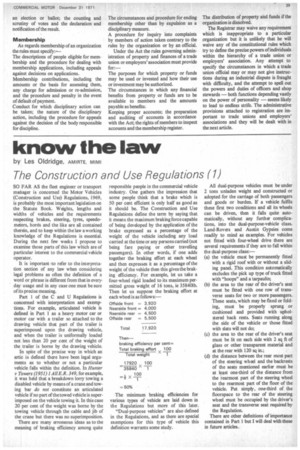know the law
Page 41

If you've noticed an error in this article please click here to report it so we can fix it.
by Les Oldridge, AMIRTE, MIMI
The Construction and Use Regulations (1)
SO FAR AS the fleet engineer or transport manager is concerned the Motor Vehicles (Construction and Use) Regulations, 1969. is probably the most important legislation on the Statute Book. Weights, lengths and widths of vehicles and the requirements respecting brakes, steering, tyres, speedometers, horns and the like are all contained therein, and to keep within the law a working knowledge of the Regulations is essential. During the next few weeks I propose to examine those parts of this law which are of particular interest to the commercial vehicle operator.
It is important -to refer to the interpretation section of any law when considering legal problems as often the definition of a word or phrase is different from that in everyday usage and in any case one must be sure of its precise meaning.
Part 1 of the C and U Regulations is concerned with interpretation and exemptions. For example, articulated vehicle is defined in Part 1 as a heavy motor car or motor car with a trailer so attached to the drawing vehicle that part of the trailer is superimposed upon the drawing vehicle, and when the trailer is uniformally loaded not less than 20 per cent of the weight of the trailer is borne by the drawing vehicle.
In spite of the precise way in which an artic is defined there have been legal arguments as to whether or not a particular vehicle falls within the definition. In Hunter v Towers (1951) 1 All E.R. 349, for example, it was held that a breakdown lorry towing a disabled vehicle by means of a crane and towing bar do not constitute an articulated vehicle if no part of the towed vehicle is superimposed on the vehicle towing it. In this case 20 per cent of the weight was borne by the towing vehicle through the cable and jib of the crane but there was no superimposition.
There are many erroneous ideas as to the meaning of braking efficiency among quite responsible people in the commercial vehicle industry. One gathers the impression that some people think that a brake which is 50 per cent efficient is only half as good as it should be. The Construction and Use Regulations define the term by saying that it means the maximum braking force capable of being developed by the application of the brake expressed as a percentage of the weight of the vehicle including any load carried at the time or any persons carried (not being fare paying or other travelling passengers). In other words, if one adds together the braking effort at each wheel and then expresses it as a percentage of the weight of the vehicle then this gives the braking efficiency. For example, let us take a four-wheel rigid loaded to its maximum permitted gross weight of 16 tons, ie 35840Ib. Then let us suppose the braking effort at each wheel is as follows:— The minimum braking efficiencies for various types of vehicle are laid down in the Regulations but more of this later.
"Dual-purpose vehicles" are also defined in the Regulations, and as there are special exemptions for this type of vehicle this definition warrants some study.
All dual-purpose vehicles must be under 2 tons unladen weight and constructed or adopted for the carriage of both passengers and goods or burden. If a vehicle fulfils these first two conditions and all its wheels can be driven, then it falls quite automatically, without any further complications, into the dual-purpose-vehicle class. Land-Rovers and Austin Gypsies come readily to mind as examples. For vehicles not fitted with four-wheel drive there are several requirements if they are to fall within the dual-purpose class:—
(a) the vehicle must be permanently fitted with a rigid roof with or without a sliding panel. This condition automatically excludes the pick up type of truck fitted with "hoops" and a tarpaulin; (b) the area to the rear of the driver's seat must be fitted with one row of transverse seats for two or more passengers. These seats, which may be fixed or folding, must be properly sprung or cushioned and provided with upholstered back rests. Seats running along the side of the vehicle or those fitted with slats will not do; (c) the area to the rear of the driver's seat must be lit on each side with 2 sq ft of glass or other transparent material and at the rear with 120 sq in.; (d) the distance between the rear most part of the steering wheel and the backrests of the seats mentioned earlier must be at least one-third of the distance from the rearmost part of the steering wheel to the rearmost part of the floor of the vehicle. Put simply, one-third of the floorspace to the rear of the steering wheel must be occupied by the driver's seat and the transverse seat required by the Regulation.
There are other definitions of importance contained in Part 1 but I will deal with these in future articles.












































































